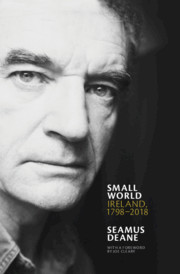32 results
Chapter 6 - Joyce’s Racial Comedy
-
-
- Book:
- Race in Irish Literature and Culture
- Published online:
- 04 January 2024
- Print publication:
- 18 January 2024, pp 121-142
-
- Chapter
- Export citation
Chapter 6 - Modernist
- from Part I - Literary Periods
-
-
- Book:
- The Cambridge Companion to Literature and Animals
- Published online:
- 26 October 2023
- Print publication:
- 09 November 2023, pp 112-131
-
- Chapter
- Export citation
Chapter 2 - Decolonizing the English Department in Ireland
- from Part I - Identities
-
-
- Book:
- Decolonizing the English Literary Curriculum
- Published online:
- 02 November 2023
- Print publication:
- 09 November 2023, pp 42-59
-
- Chapter
-
- You have access
- Open access
- HTML
- Export citation
Chapter 7 - Walter Pater, Second-Hand Stylist
- from Part I - General
-
-
- Book:
- Walter Pater and the Beginnings of English Studies
- Published online:
- 14 November 2023
- Print publication:
- 09 November 2023, pp 133-148
-
- Chapter
- Export citation
Introduction
-
- Book:
- Cybernetic Aesthetics
- Published online:
- 10 October 2023
- Print publication:
- 28 September 2023, pp 1-24
-
- Chapter
- Export citation
Chapter 2 - Hunger and Lust
-
- Book:
- Edible Arrangements
- Published online:
- 26 September 2023
- Print publication:
- 31 August 2023, pp 60-99
-
- Chapter
- Export citation
Chapter 2 - Molecular Shakespeare – Beckett Reading Shakespeare through Joyce
-
- Book:
- Shakespeare and Beckett
- Published online:
- 19 January 2023
- Print publication:
- 26 January 2023, pp 38-72
-
- Chapter
- Export citation
Chapter 12 - James Joyce, Irish Modernism, and Watch Technology
- from Part III - Invention
-
-
- Book:
- Technology in Irish Literature and Culture
- Published online:
- 19 January 2023
- Print publication:
- 26 January 2023, pp 201-216
-
- Chapter
- Export citation
Chapter 9 - Irish Nationalism
- from Part II - 1945–1989: New Nations and New Frontiers
-
-
- Book:
- The Cambridge Companion to Twentieth-Century Literature and Politics
- Published online:
- 01 December 2022
- Print publication:
- 15 December 2022, pp 150-164
-
- Chapter
- Export citation
Chapter 2 - “She Will Drown Me with Her”
-
- Book:
- The Persistence of Realism in Modernist Fiction
- Published online:
- 08 November 2022
- Print publication:
- 06 October 2022, pp 69-100
-
- Chapter
- Export citation
Chapter 12 - Joyce’s Nonhuman Ecologies
- from Part III - Perspective
-
-
- Book:
- The New Joyce Studies
- Published online:
- 01 September 2022
- Print publication:
- 08 September 2022, pp 193-207
-
- Chapter
- Export citation
Chapter 7 - Solastalgic Modernism and the West in Irish Literature, 1900–1950
-
-
- Book:
- A History of Irish Literature and the Environment
- Published online:
- 14 July 2022
- Print publication:
- 28 July 2022, pp 150-172
-
- Chapter
- Export citation
Chapter 7 - Mutual Equality
- from Part II - Development
-
-
- Book:
- Globalization and Literary Studies
- Published online:
- 01 April 2022
- Print publication:
- 21 April 2022, pp 110-125
-
- Chapter
- Export citation
Chapter 23 - Literary Modernism
- from Part III - Literary and Critical Contexts
-
-
- Book:
- Ralph Ellison in Context
- Published online:
- 14 January 2022
- Print publication:
- 02 December 2021, pp 250-259
-
- Chapter
- Export citation
Chapter Two - Between Byzantium and Beijing
-
- Book:
- The Irish Expatriate Novel in Late Capitalist Globalization
- Published online:
- 29 October 2021
- Print publication:
- 11 November 2021, pp 84-130
-
- Chapter
- Export citation
Chapter 5 - The Double Consciousness of Modernism
-
- Book:
- Metamodernism and Contemporary British Poetry
- Published online:
- 24 September 2021
- Print publication:
- 07 October 2021, pp 117-133
-
- Chapter
- Export citation
3.2 - Gothic, the Great War and the Rise of Modernism, 1910‒1936
-
-
- Book:
- The Cambridge History of the Gothic
- Published online:
- 29 July 2021
- Print publication:
- 19 August 2021, pp 43-60
-
- Chapter
- Export citation
Chapter 4 - Contesting Wills: National Mimetic Rivalries, World War and World Literature in Ulysses
-
- Book:
- Modernism, Empire, World Literature
- Published online:
- 16 June 2021
- Print publication:
- 17 June 2021, pp 152-195
-
- Chapter
- Export citation
Chapter 6 - ‘A Wreath of Flies?’: Omeros, Epic Achievement and Impasse in ‘the Program Era’
-
- Book:
- Modernism, Empire, World Literature
- Published online:
- 16 June 2021
- Print publication:
- 17 June 2021, pp 243-275
-
- Chapter
- Export citation

Small World
- Ireland, 1798–2018
-
- Published online:
- 03 June 2021
- Print publication:
- 27 May 2021



